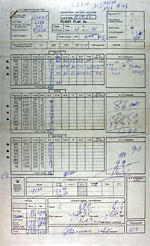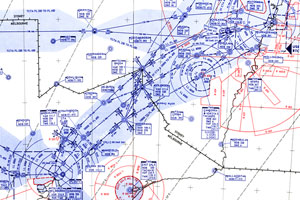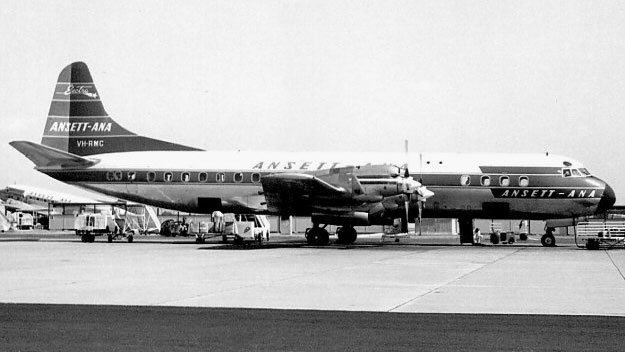
Clicking on the image at left will download a 2.5
MB .pdf file containing the complete Flight Plan (form C.A.
1488) and briefing package for Ansett L.188 Electra VH-RMC for flight
AA307 from Sydney to Melbourne on 10 October 1966.
The Flight Plan is signed, as required in those days, by the aircraft's Captain, the renowned Jason Hassard.
This collection of documents comprises the complete Flight Plan and briefing
package issued to the crew for the flight. This package includes a Pre-Flight
Information Bulletin (PFIB - NOTAMs), a Flight and Aerodrome Forecast
(Met), a Frequency Change Plan for the route and a sheet specifying Standard
Departure Clearances (SDCs) from Sydney. It would have been collected
by the crew at the Briefing Office at Sydney/Mascot before the flight.
The package
was discarded on the aircraft after the flight and preserved by an airline
employee with an eye for history! It is very rare to find such a package
intact, and having the complete package allows us considerable insight
into the operation of the airways in the late 1960s.
Points of interest
- The Flight Plan is pre-prepared for the route, only requiring time intervals to be computed, allowing for the wind on the day. Since the flight would be navigated entirely by reference to radio beacons only tracks are given, not headings.
- Three alternative air routes (DELTA, ECHO and FOXTROT) are provided, with the actual clearance being decided at taxy by ATC. These alternative routes were designed to facilitate the processing of traffic by allowing aircraft of differing speed to operate on laterally segregated routes (i.e. to minimise the problems of overtaking).

- A one-way route structure had been established on the east coast by this time, with south-west bound traffic from Sydney to Melbourne on one route and north-east bound traffic on a separate, more northerly route. Between the one-way routes was also a two-way route.
Click on the image above to refer to the High Altitude Chart 2 from
14 November 1968, covering the Melbourne-Sydney area. Of note are the
route identification letters, which can be seen on the chart.
- The route
taken in this case, DELTA, tracked via Marulan NDB,
Canberra VOR/NDB/DME,
Murray River reporting point (marking the Sydney/Melbourne FIR boundary),
Dederang VAR/NDB/DME,
Kelly reporting point, Mansfield NDB, Preston Locator and Melbourne
VOR. Within 3 years Dederang was replaced by Corryong, moving the southbound
route further south.
- In addition to being signed by the Captain, the Flight Plan is also signed as having been checked by the ATC Briefing Officer. This requirement came into being as a result of the establishment of Flight Checking Officers following the Kyeema crash in 1938.
- The met briefing uses still quite familiar terms, although it is interesting to note that what is today called the 'freezing level' is referred to as the 'flight level of the zero degree isotherm' (you can see why they changed it!). One forecasting term that has also disappeared is GRADU, meaning a gradual change. Note also the request for AIREPS (airborne reports). In those days the metorologists were heavily dependent on reports of actual conditions in flight transmitted by pilots to ATC, and passed on to MET.
- NOTAMs for the route were pre-prepared on roneoed sheets. Of interest is the Sydney VAR having been decommissioned on 25 February 1966. Also the withdrawal of the Sydney Runway 25 Localiser back-beam approach in August 1966. This was part of a general withdrawal of LLZ back-beam approaches at that time.
- The NOTAMs also refer to the commissioning of a CSF Route Surveillance Radar (primary) at Melbourne from 7 December 1965. This radar was associated with the new Bright Display ATC system and, notably, had a maximum range of 140NM.
- Also of note is the change of callsign of Melbourne Tower to Essendon Tower as of 24 September 1966. This was, of course, because of the construction of the new Melbourne/Tullamarine Airport.
- A number of interesting navaids are listed as decommissioned, including a Z-Marker (Airways Marker) at Melbourne, also the Melbourne VAR and associated Markers at Digger's Rest (DIG) and the City (CITY). Incidentally, the former CITY marker was located on the roof of DCA's Henty House headquarters!
- The penultimate page of the briefing pack contains a Frequency Change Plan, setting out the sequence of expected frequency changes for the route. There is no equivalent to this handy document in the present day.
- The final page of the briefing pack contains a list of Standard Departure Clearances from Sydney. SDCs were the predecessors of Standard Instrument Departures (SIDs) and prescribed the initial tracking after takeoff until the airway was joined. Multiple SDCs were available for the same reasons as multiple air routes existed. In this case the annotations on the document indicate that VH-RMC was cleared via SDC 52 to join route D, to cruise at Flight Level 170. Although the SDC specifies a climbing speed for Electras of 230 knots, the handwritten notes indicate that VH-RMC was instructed to climb at 210 knots.

(Photo: Barry Maclean)
Back to the main Flying Operations index
Back to the main Items of General Interest index